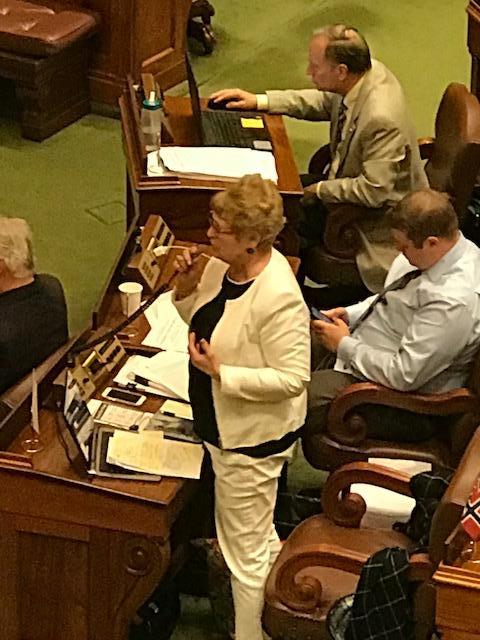
Special Session - Education Bill
**NEWS**
The Education Bill passed the Senate 34-28. It now goes to Governor Dayton's desk for signature. More details to follow in our Legislative Summary.
Despite working until midnight and beyond in the days leading up the constitutionally mandated session deadline, the 90th Legislative Session ended at midnight and a Special Session was called.
It took the 2017 Special Session to deliver the E-12 funding target and Education Bill (H.F. 2), we worked toward all regular session. In the end, many of the MSBA policies were accomplished.
Key Provisions in E-12 Education Finance Bill
Education Target: $483 million
- 2% each year on the per pupil formula ($332 million)
- $20 million for targeted early learning scholarships
- $50 million for a NEW "School Readiness Plus" program
- $3.8 million pupil transportation adjustment
- $3.6 million Math/Reading Corps
District by District Runs
Teacher Shortage
Our efforts to address the teacher shortage issue centered on recruiting, preparing and retaining teachers. Teacher Shortage Act Bill prevailed with proven provisions included in the Omnibus bill to help impact the teacher shortage issue in Minnesota.
- Alternative Preparation Grant - The alternative preparation grant allows the state to invest in new and innovative pathways for prospective educators to be trained. ($750,000)
- "Grow Your Own" or Paraprofessional Pathways to Teacher Licensure - This program is expanded from last session to benefit more schools and expand the pipeline to members of the community. ($3 million)
- Teacher Loan Forgiveness - Teacher loan forgiveness will help incent students to teach in shortage areas. ($500,000)
- Student Teachers in Shortage Areas Stipend - The student teachers in shortage areas grant provides a stipend for those candidates who are teaching in shortage areas ($1 million in Higher Education Bill).
- Concurrent Enrollment Teacher Program - Allows institutions to create or replicate the "18 Online" program providing a convenient, cost-effective way to earn the 18 credits needed to become a qualified content area concurrent enrollment instructor. ($750,000)
- Collaborative Urban and Greater Minnesota Educators of Color Program - Expands the funding to Minnesota Educators of Color Program. ($2 million)
- Concurrent Enrollment Teacher Grants - Grants to support credentialing for the next four years. ($750,000)
Unrequested Leave of Absence - R
epeals the seniority only layoff law and requires local school boards and the bargaining unit to negotiate a lay off policy.
Innovation Research Zones Pilot Program - Requires Innovation partners to research and implement innovation education programs and models.
Teacher Licensure

The Teacher Licensure Bill was included in the Education Finance Bill and contained two key components.
- Professional Educator Licensing and Standards Board (PELSB)
The first major component of the bill established a Professional Educator Licensing and Standards Board to replace the current Board of Teaching (BOT). ($1,295,000)
The second component created a four-tier licensure structure to simplify and streamline the Minnesota teacher licensure process and allow for a natural progression and eliminated complicated processes, replaced them with more open and flexible systems to accommodate the full spectrum of licensing needs. The first two tiers accommodated community experts and moved to fully credentialed five-year licensed teachers in later tiers.
Provisions Not Contained in HF2:
- Delinking Compensatory
-
Elimination of Voluntary Pre-K
- Districts currently participating in Voluntary Pre-K will continue to participate.
-
Closing of Perpich School for the Arts -
The school will remain open but is required to add new administrative roles.
-
Teacher Retirement Adjustment (TRA)
Key Education Provisions in the Tax Bill
Tax Budget: Target $650 million
- Agriculture Property Tax Credit - The final tax bill contained school building bond agriculture credit. This would provide a property tax credit on all agricultural lands equal to 40% of the property tax attributable to school capitol bond referendums. The credit applies to existing and new capital referendums. ($35.5 million for FY19)
- Minnesota State High School League (MHSL) Sales Tax Exemption -This provision makes permanent the sales tax exemption provision sunset two years ago.
- Teacher Seeking Masters Degree - A tax credit for those teachers pursuing a masters degree. ($30,000)
Key Education Provisions in the Elections Bill
- Uniform Election Dates- The bill establishes dates for all local units of government. Beginning January 1, 2018, all school elections will have to be held on one of four dates.
- Combined Polling Places - Allowed, but the school board must designate, by resolution, the combined polling places by December 31 for the following calendar year.
- The bipartisan Omnibus Elections Bill was signed by the Governor.
|